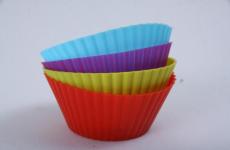Table lamp in beaded flowers. Chandelier made of beads Chandelier made of wine bottles
We had a completely stupid husband's bachelor floor lamp. The point is not even what it looked like, but the fact that it was completely non-functional, and I would like at least a minimum of functionality from it, at least just to make it light :)))
And I decided to remake it - to weave a lampshade from beads.
I invite you to get acquainted with my updated floor lamp :)
(if it’s not a masterpiece at all, but at least it works as a lighting device is supposed to work)
So, the floor lamp originally looked like this:

These were some kind of synthetic threads stretched over a cylindrical base; inside there were also vulgar plastic pendants made of “natural chrome steel” suspended, which I tore off a year before I took this photo. It was very dark and completely impractical in terms of lighting.
At one time, similar lighting devices ( ceiling lamps, sconces, floor lamps, table lamps, etc.) were very popular in the Netherlands, and succumbing general trend My husband bought it at one time.
Fortunately, the thread was cut easily and simply, so I cut the whole thing to hell with a couple of quick movements.
By this time, I had already purchased a kilogram of Czech transparent beads with rainbow coating. I bought more fishing line. For weaving, I chose monastery mesh; on one side it does not have large holes, on the other it is slightly sparse, i.e. and there will be density, and the consumption of beads will not be too high, and therefore the weight will not be too high (do not forget that the weight of beads in a large volume can be very significant - glass, after all).
And the work began:

Almost finished case (I didn’t know then that I would have to knit it a little).

I will not tell all the details of creation (if anyone is interested, they are on my blog).
And now the floor lamp is ready!
Now in the area of the living room where we don’t have a chandelier it’s light enough not to run into coffee table and not crush the tails of our cats (there are no plans to read by its light).
Weaving time - approx. three months 2-3 hours in the evenings.
The weight of the finished beaded “stocking” is 742 g.
Materials:
fishing line Maxximus ø18, length 300 m, breaking load 2 kg
Czech beads Preciosa, 9
PS Yes, our walls are crooked and not straight :))) Don’t pay attention!
A chandelier in a room is not only a lighting fixture. Without exaggeration, we can say that it is the main decoration of the room. Handmade items are considered especially valuable. This allows us to highlight the special taste of the owners of the home, as well as their extraordinary and creative mind. Of course, this type of work is quite complex and requires increased concentration. But at the same time, when creating decorations for your home, you can find many interesting and extraordinary solutions in it!
This article presents some ideas for decorating a chandelier with your own hands, as well as instructions for them. Everything is written so simply and clearly that anyone can do it at home.
In order to make a chandelier, sometimes the most unusual materials are used. For example, everyone is already familiar with glass or wood, plastic, and so on. But sometimes, when you want something completely “unusual,” wooden skewers and glass bottles wine bottles, and cans, and all kinds of tree branches, and cardboard, and even straw. You need to choose depending on the idea of the creator and the wishes of the apartment owners. You also need to take into account the general interior of the room where the finished product is supposed to be placed.

Interesting idea for a chandelier made from plastic spoons
Plastic spoons for disposable meals are one of the simplest and most easily available materials for creating a chandelier for a room. Their advantages are low price, variety color range and such material will last quite a long time for a long time. To create such an extraordinary chandelier, you will need a minimum of investments, both physical and material.
Materials:
- empty bottle drinking water, volume 5 liters;
- plastic spoons (their number depends on the size of the bottle);
- glue for plastic;
- old chandelier(or rather, a cartridge from it);
- sharpened knife.
Process of creation:
- First you need to prepare a plastic bottle for subsequent steps. Remove the label in advance, cut off the bottom, dry well.
- Then you need to remove the plastic spoons from the packaging and carefully cut off the unnecessary handles with a knife, leaving about 2-3 centimeters above the level of the “scoop”.
- You need to glue the scoop blanks to the base of the bottle. Apply a large amount of glue to the remaining “tail” and press it to the surface (with the convex side of the spoon facing out). It is necessary to cover the entire bottle in a circle until the entire perimeter is occupied by plastic “spoons”. It is advisable to arrange them in a checkerboard pattern and slightly move them together. This will leave fewer “free spots”.
- You need to remove the cartridge from the old unnecessary chandelier, and then place it in an already glued and dried bottle and fix it to the frame.
- A decorative bowl can also be made from plastic spoons: “scoops” are glued around the neck of the eggplant.
- Install and connect the chandelier, check its operation.

Note! The option of decorative painting or painting of spoons in absolutely any color is possible. Thus, your product will look even more beautiful and more original!


Chandelier made of plastic bottles in the form of leaves
One more an unusual option The interior will feature a chandelier in the shape of leaves. It is created from simple plastic bottles, the variety of colors of which allows you to work in the most unusual colors and embody the most daring ideas.
Process of creation:
- Cut plastic bottles into blanks shaped like future leaves.
- For each workpiece, the sheet shape is finally fixed.
- Using a soldering iron with a thick tip and a one-sided bevel, you need to slightly fuse the sections of each leaf in order to give the future product greatest effect.
- In the same way, using a soldering iron, you need to give the workpieces a sheet structure. You need to act extremely carefully and accurately, because you can easily make a hole in the plastic. Such a leaf with outlined veins and slightly fused edges will look complete.
- Using a hot needle, you need to melt several holes at the “leg” of each leaf in order to attach them.
- Using thin wire, form branches and screw them to a steel wire frame.

It would also be a great idea to make a new chandelier in the form of a lampshade for a floor lamp or a table lamp. Thus, it will be a great addition to the previous product!

Chandelier with paper butterflies
The most common product option is a chandelier with butterflies. And this is not without reason. Let's start with the fact that this option looks luxurious and expensive, and secondly, its production does not require any special physical costs. Thus, even a child can participate in creating a chandelier.
Process of creation:
- It is based on either an old chandelier or a similar frame. If you don’t have one, then you can take the simplest wooden or metal rim. If such material is not available, then, as an option, you can take thick wire and make about 2-3 skeins, so that a circle is formed.
- Cut out butterflies from paper according to the template. You need to take the butterfly template and adjust it to the desired size. The option also looks very unusual when butterflies of several sizes are located on the chandelier (again, depending on desire). Transfer the outlines onto paper and carefully cut out, preferably with a sharpened stationery knife, or small, non-rounded scissors. For the templates themselves, it is better to use a material that is dense, does not become very dirty and does not attract dust. For example, velvet paper is very poorly suited for the product, because in the future you will need to vacuum the chandelier quite often.
- Take a nylon thread or transparent fishing line and attach the butterflies to it. There are two types of fastening: either piercing the bodies of the butterflies, or gluing them with silicone glue.
- Next, we attach the threads with butterflies to the base of the frame and decorate it.
- You can also try interesting option, if you make a wire ball! As a basis, you should take a pendant from a chandelier and place several butterfly templates on it using a glue gun.



Fabric chandelier
This chandelier is also based on a frame. As in the previous version, either old metal frames or thick wire are suitable for its manufacture.
After you have pre-prepared the base, start cutting out the fabric from which the lampshade will be made in the future. How long the finished product will be depends on your desire, but it is worth considering that the width of the fabric must be the same as the diameter of the frame! Once you finish the pattern, you need to do a fitting.
Another nuance is that the top of the fabric will need to be sewn directly on the frame, which means that it (the frame) must be solid. Otherwise, if it is possible to thread it directly into the fabric, then you should first fold the top edge of the pattern and stitch it, and then iron it. Then we sew a seam on the side of the product.
To prevent the lampshade from losing its shape, you should pay due attention to the material. If the fabric is too light, “airy,” then the bottom of the product should be weighted. You can use cardboard or fishing line for this.
Carefully sewn fringe, lace or braid will look just as beautiful. But do not “overload” the product! The process of creating a fabric chandelier is similar to making a lace chandelier. So you can safely experiment with the materials that are placed on the frame.


Lamp made of threads and a balloon
Materials:
- dense threads, such as wool, cotton, or jute rope - at least 1 meter;
- cartridge;
- petrolatum;
- PVA glue;
- a brush for applying glue and Vaseline (it is advisable that the brush does not fade);
- 1 or 2 pieces balloons(the first in order to work with it, and the second in order to check the finished product, if desired);
Process of creation:
- Inflate the balloon to a certain size and secure it. Remember that the finished work will exactly follow the outline of the ball! Using a marker, draw a couple of circles at the top and bottom in order to determine the boundaries of thread winding.
- Using a brush, coat the entire perimeter of the ball with Vaseline.
- Pour PVA into a plastic container and thoroughly process the threads with it (It is not advisable to apply glue to the entire length of the threads at once! Process them as you wind them around the ball!).
- Taking into account the boundaries that you drew with a marker, wind the threads around the ball. Do not forget that the future depends on the density with which you wind appearance products.
- After wrapping, you need to leave the product for a day until it is completely dry; After complete drying, you need to burst the ball and remove it through the holes.
- Cut a spot in the top and insert the cartridge.
- To be completely sure that the product is strong, you can insert a balloon into it and inflate it. In a similar way, you can check the flexibility and reliability of the lampshade.
Alternatively, you can paint the structure with a spray can or acrylic paint, attach all kinds of decorative ornaments, such as butterflies, artificial flowers or beads. Also, a great idea would be to arrange several balls in the form of a bunch of grapes and fasten them together.



Wine bottle chandelier
This version of the chandelier is a little more complex than the previous ones. Making a chandelier this way is quite difficult; the manufacturing process will require care and attention. However, you will like the result!
Materials:
- wine bottle;
- glass cutter;
- sandpaper for sanding edges;
- cartridge;
- electrical wire;
- metal or wooden frame, rim.
Process of creation:
- First you need to prepare the bottle itself for further manipulations with it. The first step is to draw at the level you need straight line along the perimeter. This is required in order to cut off the bottom of the bottle using a glass cutter;
- To avoid cutting yourself on the glass, you need to sand the sharp edges sandpaper;
- Pull the wire through the neck of the bottle and then connect the socket;
- Attach the bottle to the frame.
You can also decorate the bottle with all sorts of decorative items, or leave it in its original form. In any case, it will look original and impressive.
The number of products on the frame depends on your desire. You can either leave one bottle or secure four or more bottles at once.



Laserdisc chandelier idea
This idea is great for those who have a large number of laser discs left in the house, but don’t dare throw them away. It’s worth noting right away that manufacturing options and the result can be very different. It all depends on your imagination and creativity!
Materials:
- two round wooden planks of different thicknesses, and which are slightly larger in diameter than the disks;
- racks made of metal or wood;
- Fluorescent Lamp;
- magnetic switch;
- disks.
Process of creation:
- Make a hole in a thicker board and install a starter with a switch in it.
- Then connect it all to the lamp.
- String disks onto the lamp.
- Place the stands around the discs and secure the top.
The finished product will delight its owners for a long time, and it does not require special care. It is not advisable to place this type of chandelier in a child’s room so that the child cannot harm himself (only if the chandelier hangs out of reach).


Shabby chic chandelier
To create spectacular lighting in a room, you can also make a chandelier from fabric or beads. The result will be a kind of candelabra or lampshade in the “shabby chic” style.
Materials:
- a ready-made metal or wooden frame (or it can be made from an old hoop, garden basket, thick wire);
- socket and lamp;
- chains and threads for decoration;
- all kinds of beads and seed beads.
Working on such a lampshade is not difficult, but it is a very painstaking task. Such chandeliers usually consist of two or three levels of rings, which are located on top of each other. It all depends on the size of the chosen bases. If you take rings of the same diameter, the finished product will be made in the “modern” style.
One of important points is that before you start decorating the chandelier you need to paint and wrap the frames with decorative materials!
The approximate consumption of beads is:
- For the lower part of the lampshade - 16 mm beads, about 15-17 pieces per thread;
- For the upper part of the lampshade - 12 mm beads, about 35 pieces per thread.
Naturally, when stringing beads on a thread, you can increase or decrease their number or the degree of thread tension. But it is still advisable to stock up on materials in excess of the norm.
The essence of the work is to hang threads with beads in a “waterfall” or “cascade” so that they flow downward along the structure.
In order to create the effect of “muting” the light, you can sheathe the frame with thick fabric.

A DIY chandelier will definitely add a fresh touch, originality and beauty to your interior. You will immediately notice how the room will sparkle with new colors, and your guests will sincerely admire your creativity, hard work and original taste!
90 photos of DIY chandelier ideas











































Some time ago, I decided to remake my husband’s absolutely stupid bachelor’s floor lamp, and decided to weave a beaded lampshade onto it.
Various circumstances prevented me from finishing the work earlier, but I finally did it.
I invite you to get acquainted with my updated floor lamp :)
(If anything, this is not a masterpiece at all, but it looks much better than before)
So, the floor lamp originally looked like this:
it was some kind of synthetic thread stretched over a cylindrical base, it was very dark and completely impractical, in my subjective opinion.

Fortunately, the thread was cut easily and simply, but with a couple of quick movements I cut the whole thing to hell.
By this time, I had already purchased a kilogram of Czech transparent beads with rainbow coating. For weaving, I chose the monastery net; on one side it has no large gaps, on the other it is slightly sparse, i.e. and the density will not be too high and the consumption will not be too high, and therefore the weight will not be too high (do not forget that the weight of beads in a large volume can be very significant - glass, after all).
And the work began:

An almost finished case (I didn’t know then that I would have to finish knitting it).

Trying on the cover showed that it changes shape, so I had to think about what kind of base to make. The first thought was, of course, banal plexiglass. It’s funny, but it turns out it’s not so easy to buy, or rather there’s plenty of it, but specialized off-line stores don’t have thin sheets. The Internet is the power, so we found a site with a large assortment of any plastic materials. However, the purchase demonstrated that it is so rigid that it is extremely difficult to roll it, and Google said that for this purpose, specialized equipment is needed, which, of course, is not available at home. Then I wrote to the company where I purchased the plexiglass sheet, and they recommended me a slightly different plastic (on the website it is called polyester), 1 mm thick. The recommended plastic really turned out to be more plastic and at the same time elastic, I without special effort I could roll it up. And if the plexiglass sheets were exactly the size that I needed to create the mold, then the polyester sheets were almost 2 times larger, i.e. I had to cut the sheet to the required size. A test on the edge showed that my tailor’s scissors cut it perfectly and easily, which made me incredibly happy, since I didn’t have to look for any additional tools for cutting. I marked the sheet and cut out the required size piece for the floor lamp.
Plastic has a protective film: milky on one side, transparent on the other, while the plastic itself is completely transparent.

Onyx, of course, is right there helping - I can’t cope without it on my own, guys!
Now the question arose of how to make holes in it - I would need to secure it to the frame. There are 2 options - drill or melt. I made my husband get a drill - no, but what?! he was on vacation at that time :))) - but that was not the case, the drill got stuck in the plastic and did not want to drill into it. The doctor said to the morgue, that means to the morgue! So we'll melt it. I took an awl and... oh, yes, I’m still doing all this only on a test narrow trim.

The testing was successful, the main thing is not to overheat the awl so that the plastic does not darken when melting and periodically remove the sticking plastic from the awl - it formed such rings at a wider angle (sorry that it’s cloudy).

Now it was time to start marking. Since I did not remove the protective film, I made markings on it with a thin permanent marker.

And here I already have holes melted all around the perimeter.

When burning, molten material flows onto the plastic and you have to remove it; it can be removed quite easily, but you need a knife and caution. Here you can see the melted circles that have been lifted and removed:

I removed the film and tied the plastic with fishing line to the frame of the floor lamp:
This photo shows the joining seam of the sheet

But here is the whole thing.

And the X moment came, which unfortunately showed that my beaded stocking was almost not long enough.
It’s a pity that it didn’t work on the first try, but it doesn’t matter, we’ll get there.

In the process of putting on and taking off, I had an accident in one place, but not critical - after all, monastery weaving is very good in that it does not fall apart thanks to the spiral passage of the fishing line, which is, as it were, duplicated. Only 3 beads fell out.

I opened the hole a little to secure the torn piece of fishing line and restored the knitting.
Here is just before tightening the line at the place where the mating is restored:

And here is the place after the cover was put on (I specially marked it with a red thread so that I knew where it was).

Well, the final chord - the floor lamp is ready!
The weight of the finished beaded “stocking” is 742 g.
Materials:
fishing line Maxximus 300 m / 2 kg
Czech beads Preciosa, 9
Having seen a white table lamp without any decorations in the store, I decided to definitely buy it in order to make something unusual and beautiful out of it. And this is what came out of it:
And I did it like this...
To work you will need:
- desk lamp white with a white lampshade.
- beads of red, silver, green colors,
- beads with a diameter of about 0.3-0.4 mm or large beads of white or cream color,
- fishing line,
- wire 0.4mm,
- the thicker the wire for the base, the better,
- scissors,
- green satin ribbon.
First I wove flowers.
I collected as many beads as possible onto the wire without cutting them off the spool and made a loop.
I placed 15 beads on the resulting axis and made 1 revolution around the axis,
Finished the petal.
To do this, I collected 3 beads onto a wire, folded it in half and immediately strung a bead onto 2 wires and collected enough silver beads to get approximately the length of a petal. Next, I disconnected the wire and collected silver beads again, now comparing the length with the already collected beads. Then I strung a bead and again 3 beads. Then, holding the last 3 beads, I passed the wire into the already collected beads in reverse direction. I did this 3 more times. It turned out 5 stamens. A light-colored bead was placed in the center of the entire structure.
To do this, I collected 1 bead on a wire, folded both wires in half and strung 7 beads on 2 wires at the same time, separated the wires again and collected beads on each one with a length equal to the length of the petal or a little more. I folded the wires again and put 1 bead on both. The result is a loop.
I disconnected the wires and put on more beads, now equal to the length of the already woven leaf. Then I passed the wire in the opposite direction, through 6 beads, leaving the outermost bead as the top of the petal. Then I collected green beads again and passed the wire through the 3rd bead from the base. The result is another loop, separated from the previous one by 2 beads. I made 5 of these loops.
This is what he looks like.
Now I took the central part (stamens) and screwed it to a thick wire, which became the base of the structure.
And then, one by one, I screwed all 7 flower petals in a circle, overlapping each other.
At the end I screwed on the sepal.
The first flower is ready.
Now you need to weave 4 more flowers using the same technique, only on each axis when weaving the petals I reduce the number of beads.
First I weave with 11 beads, then with 7, then 2 flowers with 5 beads at the base of the axis.
And on the last 3 flowers I did not add beads to the stamens. Everything else is the same as when weaving the first flower.
We also collect these flowers onto separate thick wires and use a glue gun to glue a satin ribbon around the thick wire, trying to hide all the “dirty” work. We wrap the wire with tape for about 10 cm.
But that is not all. Now you need to weave leaves from green beads.
I do everything the same as when weaving petals, only on the axis I collect 5 beads for the central leaf and 7 beads for the side ones. On each leaf we go around the axis 3 times.
Each branch with leaves will require 3 leaves. You need 4 of these branches and 3 more leaves that will not be on the branch; I finished the branch with them.
Therefore, we weave 5 leaves with 5 beads on the axis and 10 leaves with 7 beads.
Now we take a thick wire and attach the first small leaf. We wrap the wire with a glue gun and satin ribbon, hiding it completely. Having wound 2 centimeters of tape, we attach 2 larger leaves in pairs, and wrap the wire again.
We make 4 branches like this.
We leave 3 more leaves just like that.
Now we take the wire with the first large flower and wrap it with satin ribbon for 7-10 centimeters. It all depends on the size of the lampshade.
Again, after 7-10cm, add a flower slightly smaller than the first, and so on, alternating flowers and twigs.
Having tried the design on the lampshade and decided where the branch will end, we cut off the excess wire. And we finish winding the wire by adding single leaves.
Then, using a thin wire, carefully attach the branch to the lampshade at the top and bottom. If necessary, we “grab” the branch in 2-3 more places so that it “does not wander.”
It already turned out very beautiful, but I didn’t stop there.
And I decided to braid the lower part of the lamp with a mesh of beads. Now I took the fishing line of such a length that it would be convenient to work. I put 47 beads on the center and tightened the circle with 1 additional bead passed through both ends of the fishing line towards each other.
Then I collected 23 beads on both ends of the fishing line and again tightened the second circle with an additional bead. I continued weaving until the length of the resulting chain became equal to the circumference of the central part of the lamp.
On the diagram I drew an approximate grid pattern.
In subsequent rows I reduced the number of beads, due to round shape lamp base.
Look at the diagram. It will be more clear.






